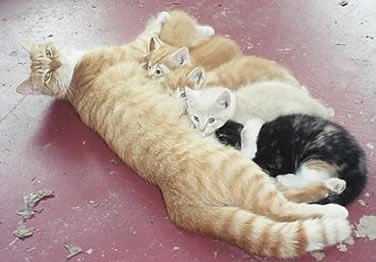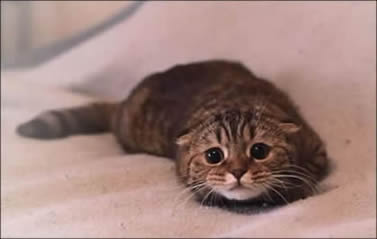|
|
Adaptive Value
The Value of Low Frequency
The fundamental frequency of a domestic cat’s purr, approximately 26.3 Hz, is a very low frequency relative to other cat and mammalian vocalizations [10]. This low frequency, while excellent for producing vibrations, is very difficult to hear, which calls into question its utility as a means of communication. It is known that cats are able to produce more audible vocalizations with frequencies as high as 150 Hz [14]. Interestingly, the purring frequency is low in all the purring species within the Felidae family. As discussed in the Mechanism page, the large felids that are able to purr do so at approximately the same frequency as the domestic cat, suggesting that there is strong selective pressure for the purr to remain at a low frequency.
What are the benefits of purring a low, nearly inaudible frequency? As mentioned in the Ontogeny page, two-day old domestic kittens were first observed to purr while suckling from the mother [15]. A popular opinion in the current literature on the subject is that this low frequency is related to an evolutionary instinct in the young to avoid detection by predators [14]. One hypothesis is that low-frequency purring is a mechanism by which kittens communicate contentment to their mother without announcing their location to possible predators.
|

Figure 1. A mother and her nursing kittens. Source
|
Purring and Human Responses: The Manipulative Potential of the Purr
It is possible that the original selective pressure that led to purring behavior was a need for close-range communication between mother and kitten. Why, then, do cats continue to purr once they are adults? Adult domestic cats are known to purr in a variety of contexts, mostly involving cat-human interaction and/or tactile stimulation such as petting [14]. A study by McComb et al. (2009) examined the role of purring in solicitation contexts between humans and cats, such as when a cat is seeking food from their owner [8]. The researchers recorded “solicitation” purrs from domestic cats, which were recorded when the cats were actively seeking food, and “neutral” purrs, recorded in non-solicitation contexts. Samples of representative solicitation and neutral purrs from the study are provided below.
Neutral purr:
Soliciation purr:
Human participants were asked to listen to these purrs and rate then in terms of their perceived pleasantness and level of urgency. Listeners rated the solicitation purr to be significantly less pleasant and more urgent than the neutral purrs [8]. Interestingly, even listeners who had no experience with owning cats rated the solicitation purrs less pleasant and more urgent. The researchers examined the audio composition of the two purr types and found that the solicitation purr contained a high frequency component embedded within the otherwise low-frequency purr. The neutral purr, however, contained no unusual high frequency vocalizations. The presence of the high frequency vocalization was strongly correlated with purrs judged to be less pleasant and more urgent. Because of its resemblance to the cry of a human infant, the researchers hypothesized that the high frequency vocalization found in the solicitation purr evolved to exploit the sensory bias of humans towards high pitched cries usually produced by infants [8].
|

Figure 2. A cat soliciting attention from its owner. Source
|
Purring: Pain vs. Pleasure
Although it is traditional to interpret purring as indicative of contentment in the cat, it is produced in a wide variety of circumstances. Notably, veterinarians report that chronically ill or severely injured cats purr almost continuously [16]. This observation suggests that there may be a dual adaptive value for purring. Purring can be used to express contentment in pleasurable contexts, or to solicit contact and care when the animal is ill. Both of these functions could have derived from the supposed “original” function of purring as a means of communication between mother and kitten.
Further work is necessary to evaluate the hypotheses presented above. Because purring is thought to enable communication between mother and kitten that prevents eavesdropping, it would be interesting to evaluate whether the ability of a kitten to purr actually reduces the likelihood of an attack. This type of experiment would be very difficult to carry out, since it is difficult to impair a cat’s ability to purr without affecting any other respiratory functions. However, Turner and Bateson propose that, as a first step of analysis, the natural variance in purring behavior in domestic cats and kittens should be observed [14]. Additionally, since purring is used mostly in social situations, and is thought to have its origins in communication between mother and young, it would be interesting to examine how social relationships between cats are impaired when purring does not occur. Currently, however, the function of this most familiar and distinctive feature of the cat remains largely unexplored.
|
 Figure 3. Cats that are depressed or in pain may purr to
Figure 3. Cats that are depressed or in pain may purr to
comfort themselves. Source |
|
 Purring in the Domestic Cat
Purring in the Domestic Cat

